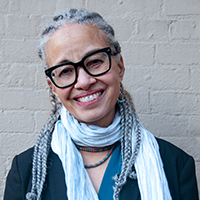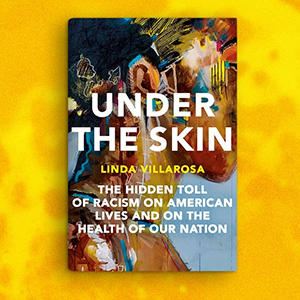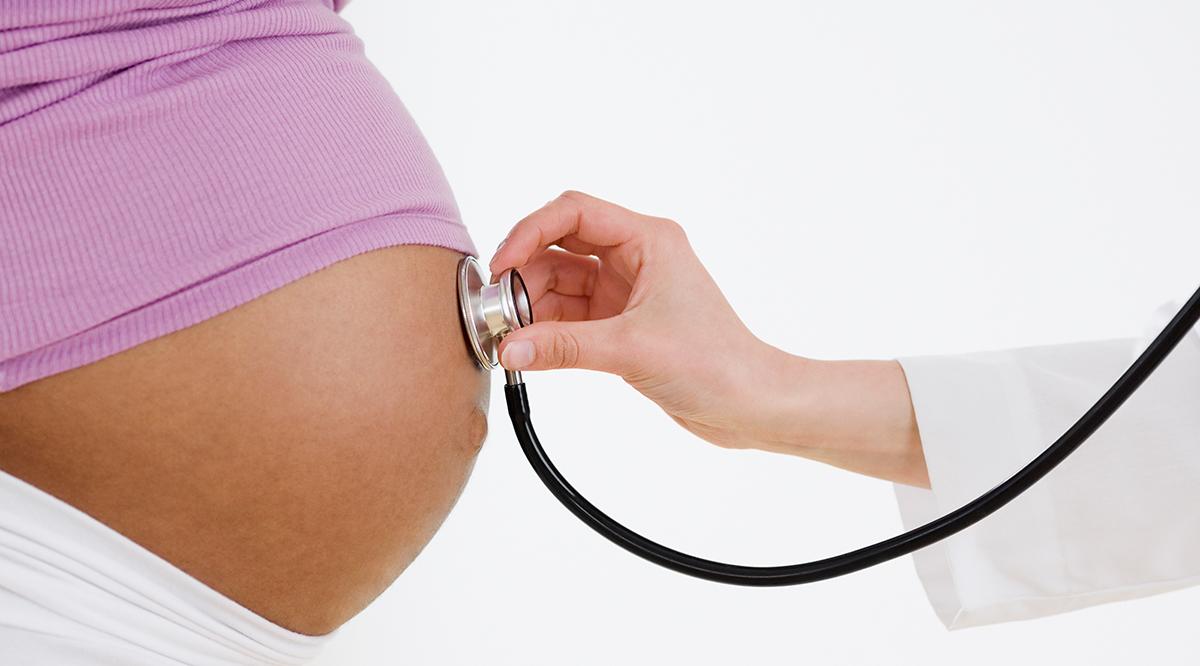As an editor at Essence, a lifestyle magazine for Black women, in the 1980s and 1990s, Linda Villarosa set out to educate Black people about how to best take care of themselves. She blamed socioeconomic hardship and lack of education for the high rates of chronic illness in the African American community and hoped that encouraging healthy habits would change those bad outcomes.
That is, until she began to dig deeper into the maternal mortality rates and disparities in the United States and discovered that Black women with college degrees were more likely to experience serious complications while giving birth than White women with only an eighth-grade education.
In her 2018 piece for The New York Times Magazine, Villarosa illuminated the data and personal stories that demonstrated how racism itself is a factor in Black women experiencing complications during pregnancy and birth. She delved deeper into this issue of racism as a driver of health inequity in her recent book, Under the Skin: The Hidden Toll of Racism on American Lives and on the Health of Our Nation.
Speaking at Learn Serve Lead 2022: the AAMC Annual Meeting, Villarosa will discuss her research, share the personal stories she’s witnessed, and explore strategies for systemic change.
Villarosa spoke with AAMCNews about her research and how academic medicine can foster change.

What role have you found that racism itself, as opposed to socioeconomic status, plays in racial health disparities?
It’s the longstanding idea that it was something about the Black body or something about Black culture that was causing poor health outcomes and racial disparities. That it was genetics. In other words, that we were inferior in some ways to White people, whether it was a lack of education or high levels of poverty, with less interrogation of societal and institutional barriers. So that’s why I really set out to write the book, to disprove that there’s something wrong with us in some inherent way. And the first chapter is basically called, “Everything I thought was wrong,” because I believed that too.
When I was a young editor at Essence, I was really looking at these poor health outcomes and looking at racial health disparities obsessively and thinking if I just tell people or help educate people that are reading Essence magazine, who are in the millions, that we can change the health outcomes of Black people in the country. And my idea was, if you know better, you do better. Then I realized, after going to public health school and really doing a lot of reporting in this area, that this kind of one-note idea that it was just poor people who were sick, was wrong. And it really came to the front of my mind in 2017, when I was reporting on maternal and infant mortality among Black women for The New York Times Magazine and I started seeing these statistics that said we’re the only country where the number of birthing people and pregnant people who die or almost die related to pregnancy and childbirth is rising. And that Black women are three to four times more likely to die or almost die, and then that a Black woman with a master’s degree or more is still more likely to die or almost die than a White woman with an eighth-grade education. And I started to [think], “Wait, this cannot be only about education or lack of money, or if you know better, you do better. There's something else going on.”
Can you share any stories about how structural racism plays out in the health care system?
Well, I think I just want to mention two of them. The first is Simone Landrum, whom I was following for my 2018 story “Why America’s Black Mothers and Babies Are in a Life-or-Death Crisis.” When I met her, she had two children. She had just lost a baby and almost died, at least partially because her doctor didn’t listen to her and her legitimate complaints.
And then when I was at her child’s birth, I saw that happening again. I was in the labor and delivery room watching the medical providers who were all White really treat her with disrespect, ignore the things she was saying, and not treat her with the kind of care and kindness you would treat someone who had gone through a trauma the year before with a stillborn baby. … And I saw how distressed she was, and that kind of distress impacted her body and her baby. Luckily, she had a healthy baby, but I still was so surprised that everything I’d been researching unfolded in front of me.
Then when my current book Under the Skin was reviewed in The New York Times Book Review, it was a Black woman writing about the book and in the middle of the review, she talked about her own birth[ing experience], and she said that she had read my 2018 story and she was trying to do everything right. She was expecting to have a positive birth outcome, but how she herself was treated during the process led her to question herself, to blame herself, and to ultimately be happy that she had a healthy baby, but also feel bad about the process and the experience. And I was surprised because right in the middle of a book review, it’s unusual to get this kind of really intense, personal story, but I appreciated it and it really confirmed much of what I have been looking into for the last few years.

Why do you think there is resistance to seeing racism as a health risk factor?
Well, I think it’s in the DNA of American character to assume that everybody has responsibility. They’re responsible for themselves and for their own health, wealth, and well-being, without questioning the forces of society and discrimination and other kinds of harm that are baked into the system. And it’s almost “un-American” to say anything bad about the country. What I learned, especially working on the [New York Times] 1619 Project, was it is Black folks who are questioning what’s going on in America and who are demanding a closer look at it, not because we don’t like the country, but because we care and want to engage in the system and work toward social change.
When I talk about discrimination and racism in the health care system itself, I’m very careful to cite a lot of evidence — and there is a lot out there — because I don’t want it to feel like I’m accusing individual physicians, nurses, midwives, health care providers, or policymakers of racism, because it’s not a question of individuals blaming individuals for their own health. It’s also not fair to blame individual health care providers for a problem in the system. And I think one of the solutions is to just admit that something is going on that is giving marginalized people a bad experience when we enter the health care system — not always but too often, and it’s been well documented. So it’s time to stop looking away from the problem and to figure out how to face it. One of the things that I’m really interested in is hospital systems and health care commissions mandating anti-racism or anti-bias, implicit bias training for its employees and to say everyone needs to go through this just as a matter of course to make sure we’re not poisoning the experience and the service that we’re giving people because they’re different from us. And I think there is a growing awareness of this and a growing acceptance of this as a solution.
What can medical schools do to start making these changes?
One thing to focus on is listening to students themselves. Many students who are in medical school and nursing school and midwifery school right now were learning about racism and discrimination against people of color — especially Black people — in high school or in college. So many of them are very aware of this and are wanting to do better and to be a different kind of provider and not take the old biases and prejudices into their practices-to-be. I think that’s really exciting, that there’s this swell of students who are trying to make a difference. And I think there are also medical educators and people that work on training medical students and nursing students who are trying to make a difference, and we have to lift up these stories and hold them up and say thank you and I’m really excited about that.
We know that medical research has abused people of color. Is there anything you’d like to see change in academic research to gain trust and stop perpetuating discrimination and abuse?
When you talk about vaccine hesitancy or Black people reluctant to enter the health care system or avoiding it, there’s this discussion of the Tuskegee syphilis study — which was in the 1930s through the 1970s — without much thought about how many people are reluctant to enter the health care system because something happened to them yesterday or something happened last week to someone that they love when they went to a doctor or went to some kind of health care provider, whether it was an extremely long wait, or it was disrespect. And I think one of the things to think about is to listen to the stories. Oftentimes, I’ve seen where hospital systems, sometimes where I did initial reporting, I went back and they’re doing a restorative justice project to both acknowledge the stories of harm and to teach the people who are working in these systems that are often busy and hurried and sometimes underfunded, that you have to listen to the folks’ stories and do better and not make the same mistakes over and over.
I think one thing that I learned over the last few years doing lectures and listening to seminars about these topics is how often Black researchers are overlooked, even when the research is about topics of interest to Black people or about diseases or problems that affect us. And I think we also have to look at who gets to study what and whose research is lifted up and whose gets celebrated — and even published. That’s one thing that I didn't know so much about, but I heard heartbreaking stories from Black researchers talking about how they were overlooked and how their research was less respected than other researchers’, even when the topic was something about Black people. So I think it’s important to also look at the ways we choose who is published and who is celebrated and who isn't.

